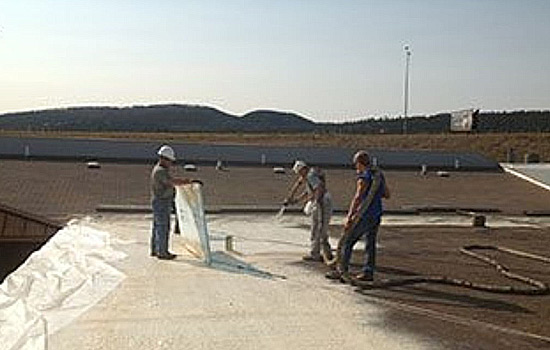Spray foam roofing or SPF (Spray Polyurethane Foam) has been around for decades since this technology was presented to the market back in the 1960s. But, of course, SPF from the 60s and SPF today are two completely different products. That being said, as it developed over the years, Spray Foam Roofing eliminated certain problems that appeared in the development process.
Nevertheless, those problems that appeared at the beginning of the development of SPF somehow remained part of it, of course, completely unfairly. Therefore, to dispel the myths related to Spray Foam Roofing, we dedicated this text to clarifying and explaining problems with Spray Polyurethane Foam that were solved long ago but, like bad breath, still remain associated with one of the most effective coating technologies.
What Is SPF or Spray Polyurethane Foam?
Spray polyurethane foam (SPF) is a popular insulation material that can be applied by spraying and is widely used to insulate buildings and seal cracks, gaps, and leaks, which helps enhancing the energy efficiency of the building while also making it more comfortable for the occupants.
Spray foam roofing is created by spraying two chemicals onto the existing roofing system through a hose. When these chemicals mix on the roof, an exothermic chemical reaction occurs, resulting in a foaming behavior. This foaming mixture expands up to 20% of its original volume, filling any cracks, crevices, or deficiencies in the roofing system, with particular attention paid to areas where protrusions like HVAC units, vents, pipes, and skylights join to the roofing structure.
As the foam dries, it forms a durable and seamless layer of protection across the entire roofing structure. This seamless layer is a significant benefit as seams are often the primary source of failure for roofing systems, and it helps to improve the long-term outlook for the roof and the building it protects.
Depending on the climate and weather conditions, there are two types of spray foam coating density: Open-cell foam and Closed-cell foam.
Open-cell foam, also known as low-density or half-pound foam, has a density of 0.5 lb. per cubic foot and typically has an R-value of 3.5 or 3.9 per inch. In contrast, closed-cell foam has a higher density of 2 lbs. per cubic foot and a higher R-value of 6 to 6.5 per inch, making it more energy-efficient than open-cell foam.
Benefits of Spray Foam Roof Solutions
As for the benefits of spray foam roof solutions, some of the most known are the following:
- Strength & Durability,
- Advanced Insulation Performance,
- Easy installation,
- Renewability, and
- Environmental friendliness.
Strength & Durability of the Spray Polyurethane Foam
Spray foam coating is recognized for its superior strength and durability. When installed and maintained correctly, SPF roofs can endure for over 20 years before requiring reapplication. Furthermore, spray foam coating can resist extreme weather conditions and severe storms, making it an excellent choice for buildings in areas prone to harsh weather.
Advanced Insulation Performance
Unlike many other insulation options, Spray Polyurethane Foam has an exceptionally high R-factor, which measures the level of insulation a product provides. The high R-factor of Spray Foam Roof makes it the top choice for minimizing thermal fluctuations and reducing heating costs.
Easy installation
One of the advantages of SPF roof coating is its easy installation process. With minimal preparation and no tear-off required, a spray foam roof can be installed quickly and efficiently. Additionally, the minimally intrusive nature of the spray foam installation means it won’t disrupt your day-to-day business activities, so you won’t lose any potential income.
Renewability
Spray foam roofing is also valued for its renewability, which means that SPF can be reapplied when necessary. This attribute enhances the durability and lifespan of your commercial roof, saving your business money in the long term.
Environmental Friendliness of the Spray Polyurethane Foam
Spray foam roofs offer several eco-friendly benefits. Firstly, SPF is an environmentally friendly material because the substances used to produce it have zero ozone-depleting potential. Also, spray foam helps reflect UV rays, lowering air conditioning expenses. Furthermore, spray foam installation requires minimal tear-off of the existing roof, resulting in minimal waste.
The Truth About Spray Foam Roofing Problems
Now that we have covered all the benefits of using SPF, it’s time to debunk the myths surrounding Spray Foam Roofing problems.
Myth Problem No. 1 – Spray Foam Roofs Are Expensive
Although this statement is held in public, we have to say that it has no basis, and here is why. As we have already emphasized, Spray Foam Roofs are long-lasting and have excellent insulating performance. Therefore, when we include the savings you get with these benefits, the value of installing SPF is multiple. In addition, the approximate price of installing SPF is about $7.00 per square foot, which is more than favorable, mainly since that price includes the material as well as the cost of installation.
Myth Problem No. 2 – Spray Polyurethane Foam Roofing Isn’t Durable
This myth follows Spray Polyurethane Foam from its early stages. However, as explained in the benefits, you can count on longevity with SPF since roofs coated with Spray Polyurethane Foam can last up to 20 years.
Myth Problem No. 3 – You Can’t Walk Over SPF-Treated Roof
One more myth that doesn’t have a basis in reality since, if properly installed, Spray Foam Roofs are completely safe for walking. What should be taken into account when it comes to walking on roofs covered with Spray Polyurethane Foam is that you should not walk in inadequate shoes, especially not those with sharp soles, so that they do not damage the surface.
Myth Problem No. 4 – SPF Isn’t Suitable for Roofing
Since Spray Polyurethane Foam (SPF) was initially used for refrigeration and industrial insulation, it was believed to be unsuitable for roofs. However, it’s important to note that this opinion was popular during SPF’s early stages when it was still developing. Today, Spray Polyurethane Foam is applied by roofing standards and offers numerous benefits.
Spray Foam Roofing Problems That Are Real
While we previously discussed certain myths related to problems with SPF, it’s important to acknowledge that, like any technology, Spray Foam Roofing has its own set of issues. However, these problems are not insurmountable, and they shouldn’t discourage the use of SPF altogether.
The most obvious problem with using Spray Polyurethane Foam is weather-related. It means that it needs to be extremely warm and dry weather, with no wind, for SPF installation to be carried out easily.
Another issue related to spray foam roofing is the punctures that rough weather conditions can cause. In order to spot these punctures in time and solve them before they lead to leakage problems, it is necessary to carry out regular roof inspections as well as regularly maintain the roof covered with SPF.
Finally, it’s worth noting that if Spray Polyurethane Foam (SPF) is not installed correctly, there is a risk of overspray. This occurs when droplets of the material land on areas of the building or property where they’re not intended to be.
That’s why it is essential to find a knowledgeable and experienced roofing contractor to install SPF in a proper way.
Finding the Right Contractor for SPF Coating
If you’re searching for a reliable roofing contractor to apply SPF coating to your roof, look no further than MK Roofing. Our team has extensive experience and expertise in all types of commercial roofing services, including spray roof coating.
We’re known for our commitment to honesty and integrity, making us the top choice for businesses in New Jersey seeking the best commercial roofing services.
Therefore, don’t hesitate to reach us when you opt-in for Spray Foam Roofing; our phone is 908-323-9686. We are here to help.

